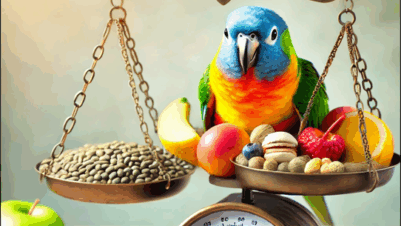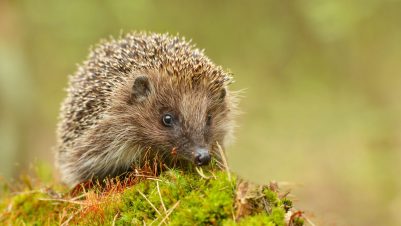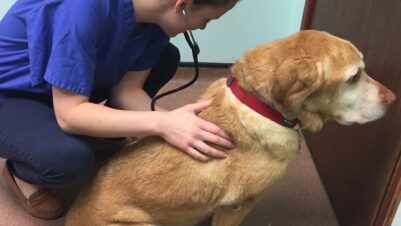Like many pet owners, I am no stranger to the challenges that come with caring for an elderly pet in their twilight years. Whether this has been a more traditional companion species such as a dog or cat, or more unconventional species such as chickens and ducks, hamsters, rabbits or even fish, each come with their own challenges and behavioural requirements towards the end of life.
Care of the elderly pet is supported by an understanding of the animal’s overall behaviour patterns as well as knowledge of the personality and habits of the specific individual pet, and grounded with information about the process of ageing and how it affects the animal’s body. To understand these things you might ask yourself, “what should this species be capable of doing?”, “what should my pet be doing normally?” and “what is specific to ageing in this particular species?”, respectively.
As a general rule for all elderly pets, a familiar husbandry routine is key to keeping the animal comfortable and providing them with an element of control over their day-to-day life
As a general rule for all elderly pets, a familiar husbandry routine is key to keeping the animal comfortable and providing them with an element of control over their day-to-day life.
Common physical changes in elderly pets
The biological process of ageing is termed senescence. Changes in physical characteristics are evident in elderly pets, such as loss of muscle and body condition, and changes to integument colour – animals can “go grey” too. It is important not to consider ageing in human terms when we judge elderly characteristics in our pets: many species of animal will suddenly “look old” without the long period of gradual degeneration that we are familiar with in humans.
Arthritis and other changes to joint movement and flexibility associated with ageing will also change behaviour and can become a welfare concern. Sudden pain or tenderness can be noticed by an owner during day-to-day interactions with a pet, and veterinary advice should be sought if there are impacts on normal activity and behaviour.
Common behavioural changes in elderly pets
Some of the most noticeable behavioural changes associated with senescence are a slowing down of movement, potential difficulties in locomotion and a less varied activity pattern overall.
Another less understood but commonplace behaviour change associated with ageing is an increase in anxiety and potential restlessness. Anxiety can manifest as changes to personality or normal characteristics, for example an increase in repetitive behaviour patterns such as rocking or pacing, lethargy and staring “into the middle distance”, or responding to phantom stimuli like non-existent sounds or cues. More specifically, elderly cats can find changes to routine challenging, and a lack of familiar scents in the cat’s immediate environment can cause anxiety and behavioural upset.
Common age-related changes in traditional domesticated species
For dogs and cats, changes to awareness and behaviour can be parallel with those seen in their human owners. Hearing, for example, becomes less fine-tuned, and dogs and cats can suffer from cognitive dysfunction syndrome, which is similar to Alzheimer’s disease in humans.
Elderly animals can gain weight due to more limited mobility, and this too will impact on behaviour and quality of life. Limited mobility may also be associated with soiling around the house as the dog or cat may struggle to reach normal toileting areas. Conditions such as osteoarthritis, cystitis and neurological disorders, as well as psychological deterioration such as separation anxiety, can also increase the chances of soiling in the pet’s bedding or in areas around the home.
For species where anatomical changes are associated with ageing, changes to specific aspects of husbandry and management will be required
For species where anatomical changes are associated with ageing, changes to specific aspects of husbandry and management will be required. For example, horses have constantly erupting teeth whereby the incisors, premolars and molars erupt from each mandible as the tooth’s surface is worn down by grazing and chewing. The facial profile of the elderly horse will look different to that of a young horse because the lower mandible will become leaner and shallower as the roots of their teeth push up and disappear. Loss of most or all teeth in elderly horses will require dietary changes as they will be unable to process hard food effectively.
Exotic and non-traditional domestic species
When the pet is of a non-traditional domestic species, recent wild ancestry may mean that the behavioural signs of discomfort, pain or distress associated with ageing may be hard to identify. Wild animals will deliberately mask signs of pain as a survival instinct to reduce the chances of attention from a predator. In such cases, the owner’s knowledge of their pet is instrumental in deciding how to best adapt daily care and in knowing when to seek veterinary treatment if any unusual changes are noted.
Wild animals will deliberately mask signs of pain as a survival instinct to reduce the chances of attention from a predator
Species such as tortoises have evolved to live for a long time. They have slow metabolic rates which means that cells do not “burn out” as quickly, as well as a specific genetic make-up of gene variants enabling DNA repair, cancer suppression and adaptive immune responses that are not possessed by other vertebrates with short lifespans. Therefore, detrimental ageing processes may be more challenging to identify, and record keeping is essential (especially if such an animal is cared for by multiple owners due to the extent of its lifespan) to know exactly how old an individual is so that appropriate veterinary care and changes to husbandry can be provided to accommodate for ageing.
Keepers of poultry, particularly chickens, ducks and turkeys that are classed as heavy “table” breeds, must be mindful that these birds are not adapted for a long life. Abrasions and abscesses to the keel (on the bird’s sternum) caused by increased resting due to increased bodyweight, alongside leg and foot problems associated with arthritis and poor weight-bearing, will become common as large “table”-breed birds age. Plumage quality may also suffer, and access to dustbathing or pools for washing and swimming can become a challenge with more restricted mobility. Observation of behaviour and movement around an enclosure can help the owner gauge how well elderly birds are able to look after themselves and will consequently help to judge if veterinary attention is required to ensure their quality of life remains good.
Keepers of poultry, particularly chickens, ducks and turkeys that are classed as heavy “table” breeds, must be mindful that these birds are not adapted for a long life
Conclusion
Quality-of-life assessments for elderly animals are vital to ensure that appropriate care can be provided during senescence. Regular veterinary checks as well as body condition scoring and behavioural assessments can ensure that a pet is comfortable, functioning well and not in pain or suffering.
Behaviour is one of the best tools for both the owner and the vet to use to determine the animal’s welfare state. Mobility can be scored as the animal is walking so that changes to the environment can be made to benefit movement and activity.
To help ensure that an elderly pet remains mobile and interested in its immediate environment you can adjust schedules of walks or playtime, as well as the number of feeds and when they occur, and how accessible resources are (height off the ground? Entry and exit points? Number of feed and water bowls? Visibility of feeding and water bowl?). These steps can provide the owner with more quality time to spend with a beloved member of the family in the pet’s later years.










